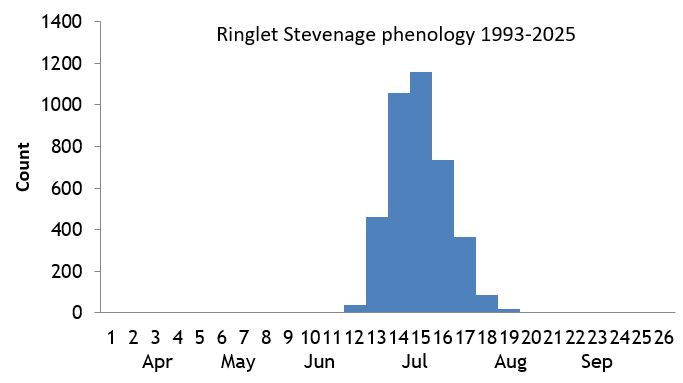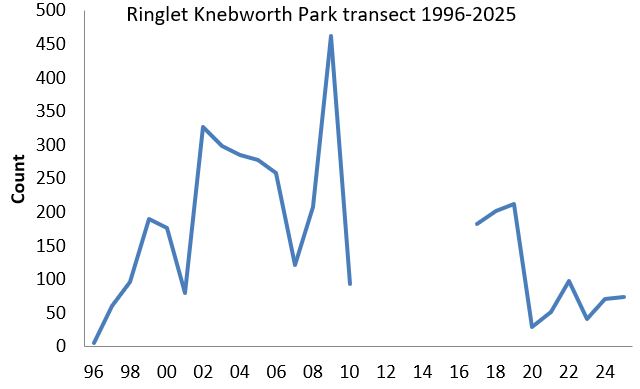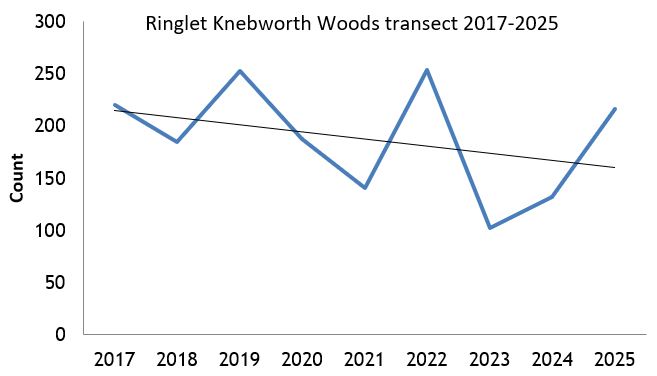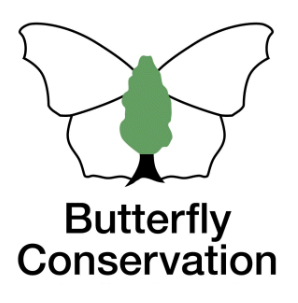Brown Argus
Brown Hairstreak
Chalkhill Blue
Clouded Yellow
Comma
Common Blue
Dark Green Fritillary
Dingy Skipper
Essex Skipper
Gatekeeper
Green Hairstreak
Green-veined White
Grizzled Skipper
Holly Blue
Large Skipper
Large White
Marbled White
Meadow Brown
Orange-tip
Painted Lady
Peacock
Purple Emperor
Purple Hairstreak
Red Admiral
Ringlet
Silver-washed Fritillary
Small Blue
Small Copper
Small Heath
Small Skipper
Small Tortoiseshell
Small White
Speckled Wood
Wall
White Admiral
White-letter Hairstreak
Extinct/rare immigrants
Ringlet
Aphantopus hyperantus
General Distribution and Status
The Ringlet is widespread and common in Britain, and continuing to extend its range although it is still absent in north-west England and the highlands of Scotland. There is some evidence of a decline in the 19th century from the industrial areas like London which may suggest that pollution was a factor and that cleaner air had enabled the butterfly to re-expand in the last century (Asher et al.). Although many colonies have been lost through over-zealous cutting of vegetation, new areas are being colonised probably through climate change. Since the 1970s its distribution has expanded coupled with more than a triple increase in abundance. This butterfly is one of our most successful in Hertfordshire and Middlesex in its distribution and population with numbers increasing at a good rate (Wood, 2016) although abundance has declined to about half of that in the 2015-19 period perhaps due to the drier summers.
| United Kingdom | Herts & Middx | |||
| Distribution | 1976-2019 | -7% | 1980-2015 | +94% |
| Average 10-year trend | -2% | 2006-2015 | +39% | |
| 2024 since 2015-19 | +18% | |||
| Abundance | 1976-2024 | +273% | 1980-2015 | +650% |
| 2015-2024 | -43% | 2006-2015 | +186% | |
| 2023-2024 | 0% | 2024 since 2015-19 | -54% | |
UK distribution map
UKBMS Species summary
Habitat Requirements
This species is found on tall, lush grassland near hedgerows, edges of woodland and woodland rides. It is scarcer in the drier areas and on arable land.
Larval Foodplants
Cock's-Foot Dactylis glomerata, Tufted Hair-grass Deschampsia cespitosa, Common Couch Elymus repens, False Brome Brachypodium sylvaticum, Meadow Grass Poa spp..
Adult Food Sources
Bramble Rubus fruticosus (37), Thistle Cirsium sp. (15), Heather Calluna vulgaris (11), Wild Marjoram Origanum vulgare (10), Buddleia Buddleja davidii (10), Common Fleabane Pulicaria dysenterica (10).
Historical Records
Earliest records suggest that the butterfly was common and widespread. Matthews noted it in the 1890s at Stevenage (Gibbs) and Palmer found many in the Knebworth woods in the 1920s. It was described as 'fairly common and widespread' by Waterton in his 1970-81 report.
Local Distribution and Abundance
As indicated on the map, the Ringlet is widespread in the Stevenage area with the highest populations in the Knebworth woods complex, Fairlands Valley Park and Great Ashby Park. An estimated 400 individuals were seen at Norton Green Common on 13 July 2001 by Trevor Chapman. On 1 July 2009, Ken King counted 241 specimens at Knebworth Park on his transect. There could be an association between early summer weather and the abundance of the Ringlet in the following year: higher temperatures and less rainfall in early summer tends to adversely affect the butterfly in some way, e.g. reduced reproductive potential of emerging females and laying fewer healthy eggs for the following year's generation. The drought in 2022 appears to have had a detrimental effect on this species because there were far fewer specimens reported in 2023 and a shorter flight period than normal.

Stevenage (South Fairlands Valley Park) transect 1993-2025
This species is now taking a turn for the worse since the heights of 2017 before when abundance was increasing. The butterfly also endured significant downturns in 2004, 2007 and 2015. The summers of 2003 and 2006 were hot and dry which may have had an effect on numbers in the following year but the declines were not so apparent elsewhere in the county. The early summers of 2014, 2017, 2018 and the spring of 2020 were warm and dry which may have withered the larval foodplants but I suspect that changes in the grass cutting regime in the park and lack of management in the woods are factors too. The long drought in 2022 appeared not to have impacted in terms of numbers flying in the summer unlike the closely related Meadow Brown. However, the season in 2023 turned out to be the worst this century.

Knebworth Park transect 1996-2010 and 2017-2025
Clearly, numbers were increasing as shown on the graph for 1996 until 2010. Some of the warmer summers in the 2000s had a negative impact on numbers in the following year, most significantly so in 2009 to 2010. Perhaps the abundance in 2009 was so high that the carrying capacity in the habitat was exceeded. The fact there was a slight increase in abundance in both 2018 and 2019 compared to the previous year seems to suggest that the habitat and the ecosystem therein, in which the Ringlet is mostly seen, in the north-western section of the park, was not affected by the warm and dry early summers in 2017 and 2018 in the same way as on the Stevenage transect. In 2020, numbers fell dramatically not only probably because of the impact of the spring drought on the larval foodplants but also the excessive grazing by deer (presence of many deer droppings) leaving fewer tall tussocks of grass which the butterfly seem to prefer. There was a good pick up in numbers in 2022 in spite of the drought like what occurred in the Stevenage transect.

Knebworth Woods transect 2017-2025
This is common and seen in all sections although most plentiful in Norton Green Common. The significant rise in numbers in 2019 is probably partly due to the cutting regime in the meadow during the previous winter when many scrubs and small trees were cut. 2022 saw a record year for this butterfly in terms of abundance with 101 counted on 3 July. On the other hand, 2023 was the worst year in terms of numbers probably because of the long drought in the previous year impacting the development of larvae on desiccated grasses - also see notes for the Stevenage transect above.

Pryor's Wood transect 2000-2022
It is common at this site. 2019 was the best year with 145 specimens counted including 41 on 8 July.Life History
Earliest date: 6 June 2015 at GlaxoSmithKline, Stevenage
Latest date: 31 August 2014 at Walkern
One generation is produced
each year with the first adults usually emerging in the last week of June. The peak period is in the middle of July and very few specimens are on the wing
after the first week of August. Females drop their eggs among the tall vegetation. By the end of July, larvae emerge and feed on the grass leaves before
entering hibernation for the winter. Feeding resumes in the spring. Pupae are formed in a cocoon at the base of a grass tussock in June.
Behaviour/Observation notes
One of the few butterflies which flies in the rain. Its dark colouring and bobbling flight over the vegetation are diagnostic for the Ringlet although a faded specimen might be confused with a male Meadow Brown. When fresh, the white fringe on the wings is clearly visible. It regularly rests and feeds on flowers and taking photographs of the butterfly should be straightforward. Early morning is the best time for upperside shots.
Variations/Aberrations
The number and patterns of the eyespots, especially on the undersides, vary for this butterfly. The 'ringlets' may become elongated
and appear pear-shaped which is classified as ab. lanceolata. As far is known, no aberrations of any sort have been reported from Hertfordshire.
Find out more on the UK Butterflies website
References

Norton Green Common 23 Jun 2017 (m)

Stevenage 6 Jul 2019 (f)

Norton Green Common 26 Jun 2017





